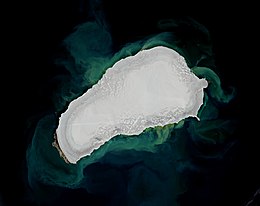Kvitøya
Kvitøya
Island in the Svalbard archipelago in the Arctic Ocean
Kvitøya (English: "White Island") is an island in the Svalbard archipelago in the Arctic Ocean, with an area of 682 square kilometres (263 sq mi). It is the easternmost part of the Kingdom of Norway. The closest Russian Arctic possession, Victoria Island, lies only 62 kilometres (39 mi) to the east of Kvitøya.
This article needs additional citations for verification. (November 2022) |
The island is almost completely covered by Kvitøyjøkulen, an ice cap with an area of 705 square kilometres (272 sq mi) with a classical, hourglass-shaped dome, which has given it its name. The few ice-free land areas are each only a few square kilometres large and very barren and rocky, the largest being Andréeneset on the southwest corner of the island. Kvitøya is a part of the Nordaust-Svalbard Nature Reserve.

